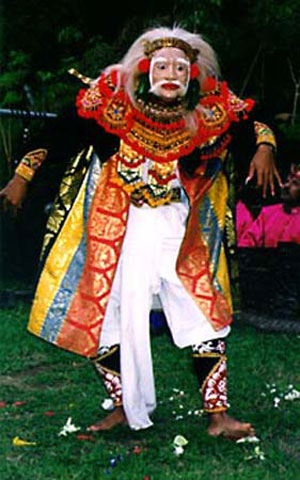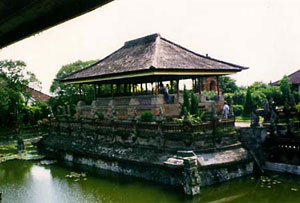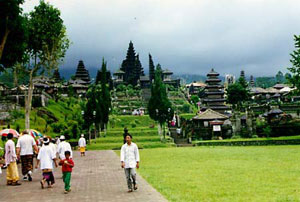 |
|
|
|
|
|
|
|
|
|
|
|
|
|
|
|
|
|
|
|
|
|
|
|
|
|
|
|
|
|
|
 |
 |
|
|
|
|
|
|
|
|
|
|
|
|

|
Bali
Island of the Gods The gamelan orchestra looses a rippling patter of stony chimes. Kendang drums swell. The masked and costumed figure steps out stiffly, all angly elbows, turned-out thighs, sinewy, insinuating fingers and creaky movements. He cocks his head like a curiously startled bird. The world-weary mien and unruly white hair on the wide-eyed mask inform that the character being depicted is the king's old counselor. With poise and balance, using stop-start staccato steps, he spins out a magical tale dramatizing the advance of years.Dusk descends over the group gathered at Four Seasons Resort, Bali at Sayan where the village's 40-member Banjar musicians and dancers perform the Topeng and other numbers on Tuesdays at 6:00. The wondrous Topeng, meaning pressed against the face as with a mask, tells the story of ancestors who descend from heaven to inhabit the masks and is a stylized blending of history, myth and magical faith. In a way it serves as a metaphor for the island. Beneath the shroud of Bali's luxuriant tropic beauty lies a living culture as mysterious as any in the world and an exquisite, refined people of utterly irresistible charm.
The religion, Agama Hindu Dhara, is Balinese Hinduism, a blend of Hindu, Buddhist, Javanese and ancient indigenous beliefs. Hinduism on Bali is a joyous manifestation that informs and shapes life. Deities and ancestors are worshipped. Evil spirits, witches and ghosts are placated. Starting at dawn and continuing throughout the day, leafs or plaited palm baskets laden with food and flowers (offerings) are presented to the Gods. More than 60 religious holidays appear on the calendar. About 20,000 temples adorn the island. Nature, religion and art converge into a celebration of beauty that is part of everyday existence. Bali's arts are an extension of its faith and all Balinese, devout servants of the Gods, are artists and cultivate dance, painting, sculpture and music. Some villages specialize in a particular form of creativity. Mas is known for woodcarving, Batubalan for stone carving, Tohpati for batik, Celuk for gold and silver jewelry, Batuan for painting, Sukawati for basket weaving, Puaya for shadow puppets and masks and Tenganan for double ikat fabric. Artisans and craftsmen sell their goods at their workshops. Bargaining is obligatory. Americans sometimes squirm at the practice and prefer a commercial setting in which prices are fixed, but the Balinese have another take on the custom. They look at it as a way of interacting and getting to know one another. Bali is a place that tugs at the soul. When I left the island after my first visit a few years ago, I knew it would not be too long before I would come back, not just to discover what had been left unseen, but to re-experience the rush that comes from the familiar. Unlocking the main door to a villa that was identical to the one in which I once stayed and being engulfed by the lush surroundings rekindled lyrical images of the beach resort, Four Seasons at Jimbaran Bay. As the key turned, I felt that every moment of the exhausting journey halfway around the world had been worth it. The hotel may only be 10 minutes from Denpassar, the people-intensive capital, at the southern tip of Bali where the international airport is located, but it is far off in a dreamworld of bales (thatched roofed pavilions), outdoor showers that define tropical bathing, massive four-poster beds with whirling fans above and private plunge pools that suggest reposing au naturel in the turquoise water. Since my last visit, new features had been added at Four Seasons. The smallish spa was replaced by a larger one with services meant to appeal to committed gym goers and sybaritic devotees of body treatments. Gardens, whirlpools, showers, dip pools with cascading fountains and courtyards that open to the sky are part of the facility. Individually tailored spa packages were introduced and alternative cuisine is available. Exercise classes take place each day. The two-hour Lulur Jimbaran for couples combines massage, exfoliation, polish, yogurt splash, a soak in a tub strewn with pedals and an application of lotion. It is not just a taste of utopia, but a tonic for overcoming jet lag. I passed on the finish, a jamu or herbal drink, as I don't much care for the taste. Belinda Shepherd, spa director, said that the oils, scrubs and lotions are madein Indonesia using native plants and products from the sea. When asked about the ubiquitous and peerless massage in Bali, she answered, "It comes from the heart. There is an attitude of caring among the people who have wonderful hands and have grown up using it within the family." Mark Miron, executive chef, arrived a little more than a year ago and has made some changes in the menus. To lend variety to the Balinese table, he prepares Sumatran-style rijsttafel. In the main dining room, Taman Wantilan, at dinnertime one can now order both classic fare and Indonesian specialties. Using recipes from several parts of Asia, Miron opened a noodle house, Warung Mie. Delicious noodle-based appetizers and entrees are served on mismatched Chinese porcelain plates. To reach Warung Mie, we stepped on stones resting in a water garden and entered a bale. The tiled-floor room, which has the ambiance of a Beijing or Hong Kong restaurant a century ago, holds a communal antique table, a long bar in front of an open kitchen and old photographs, posters and maps. One morning each week, Miron invites guests to shop with him at the local market where he buys fish and produce. As he wanders among the vendors selling live chickens, duck eggs tinted with blue, snapper, squid, tuna, mackerel and some unfamiliar creatures from the sea, he talks about how to determine what is fresh. He names the exotic fruits--mangosteen, soursap, jackfruit, rambutan, apple custard, salak, sapodilla, passion fruit and Java plum--that taste as though they were harvested in Eden. Miron also oversees cooking classes that center on selections from the menus and traditional cooking methods. Using authentic Balinese utensils, sous-chefs teach individuals and groups. Jimbaran Bay arranges sailing, tennis, instruction in massage, Indonesian martial arts and mixing tropical drinks, mountain bike trips, beach walks, beach volleyball, sunrise road runs and guided meditation for its guests. Five years after the 147-suite Jimbaran Bay property began receiving guests,the company unveiled another Balinese hideaway, Four Seasons at Sayan in the jungle highlands on the sacred Ayung River. The number of villas was scaled back to an intimate 46. Ocean and river packages are popular and a seamless transition makes staying at both an attractive option. Staff will, upon request, pack and unpack guests' bags. They photograph the toiletries on the vanity so that the articles can be laid out the same way in the new quarters. Transfers are also complimentary. To reach Sayan we crossed a long tree top-level teak-covered foot bridge straddling a tributary of the Ayung 65 feet below. If I hadn't initially been seduced by the bridge, any one of the unfolding vistas and striking architectural details would have overwhelmed me. After making my way to the elliptical lotus pond that forms the roof of the main building, I descended the stairs to reach the reception area and a sweeping 180 degree view of the valley. I was then escorted to my one-bedroom villa and entered it from the rooftop, complete with a lotus garden and wooden deck, by climbing down a circular stone stairway. The artfully decorated space below includes a terrace, pool, garden, bedroom, spacious bathing area, outdoor shower and living quarters. One of the striking details is the recessed ledges in the bedroom that hold softly illuminated collectibles. I sat on the terrace and stared at the jungle and the exquisite geometric precision of rice paddies. The rain forest across the river forms a dense green curtain, and on the first afternoon, the sounds of a tropical downpour competed with the thunder of the rapids. The weather is as beautiful during a shower as it is in sunlight. At night a chorus of frogs, birds and grasshoppers harmonized with the rhythm of the Ayung. The oval-shaped main dining room, Ayung Terrace, is as stunning as the panorama of the fields and the river onto which the room opens. Also eye-catching are the restaurant's silver and brass table accessories by John Hardy and a group of vivid masks displayed on a circular table. Some of Hardy's pieces may be purchased at the Sayan and Jimbaran Bay boutiques. Using earth and botanical substances from the region, beauty therapies were developed especially for use at The Spa at Sayan. A spice bath, suci(based on Ayurveda), clay body masque, rice and spice scrub and an earth-elements holistic facial are a few of the restorative treatments that are offered. Cooking class under the direction of Simon Purvis, the resort's chef, begins with a drive to the Gianyar market. He often stops at a babi gulingwhere guests can taste a not-to-be-missed island specialty, whole roasted suckling pig. The instruction in the kitchen, preparing native recipes as well as learning how to present them, is hands-on. Other resort activities include yoga, water aerobics, garden tours, escorted museum visits, bike rides through the neighboring villages and rice fields and valley treks.
Close by are majestic temples to explore and colorful festivals to attend. We hired a car and driver, and accompanied by a guide, we visited Pura Besakih, the holiest temple, where we climbed the many levels of the complex to observe the shrines, which number over 80, and Gunung Agung, the tallest and most sacred volcano, "the navel of the world." On that same excursion we went to Klungkung to see the Taman Gili (Royal Palace), where the overhead artwork in the Bale Kambang (Floating Pavilion) depicts daily life, and the Kertha Gosa (Hall of Justice), whose ceiling is intricately painted to show justice and punishment. On another day we attended a cremation. Tourists are welcome at these intense and joyous events, which are witnessed by hundreds, and sometimes even thousands, and celebrated like a wake. The rituals last for many hours. The elation at funerals springs from the belief that the soul has been released to join the supreme God and that heaven is just another Bali. The opportunities to sightsee and to participate in sports and outdoor activities are endless. One can hike, climb mountains, go on a camel or elephant safari, cruise, fish, sail, scuba dive, snorkel, jet or water-ski, paraglide, trek through a rice paddy, jungle or monkey forest, paddle a raft on the white water of the Ayung, walk through botanical gardens and bird and reptile sanctuaries, play golf, attend a cultural workshop or take an excursion to another island. A number of companies organize tours and private arrangements are easily made. There are many resorts and boutique properties on the island that blend with the landscape surrounding them and whose architecture is original. Our visit to a few of them was a singular treat. Almost a century has passed since Bali's long and fabled Age of Batak Kings drew to a close, but the grandeur of the ancient Hindu court echoes in the landmark Nusa Dua Beach Hotel. Fronted by a long stretch of ocean and set on a large acreage of tropical parkland, some of the design elements--the candy bentar (entryway) and bales bales, areas where the king communed with his subjects--were copied from palaces.
Nusa Dua has one of the island's largest spas. The warm and smiling staff dispense a variety of facials, massages and traditional body treatments. The ultimate spa experience is a two and one-half hour delicious combination of scents and strokes, the Ritual, which begins with a sea salt and essential oilfoot rub and is followed by an application of oil to the scalp, a facial massage and a dried coconut scrub. Raja's Table, the resort's top restaurant, serves commendable food, especially fish and seafood. A blackened tuna appetizer was fresh, smartly seared and blushingly pink. A main course of cod, fragrant with ginger and sour plum, was brilliant. Raja's Table is one of two hotel dining rooms where we discovered an unusual pricing system. The tab is determined by the number of courses. All main dishes cost the same. One can select two courses or three and be charged accordingly. Adrian Zecha, founder of Amanresorts, is a hotelier whose vision is contrary to that of most innkeepers. He thinks small. His room tally in the decade plus that he has been putting up one-of-a-kind resorts, mostly in Asia, is less than 500. Zecha's objective is to create vacation spots that "respond in an effortless way to location and to the people and culture enriching them." By concentrating on "the way light falls on a table, water fills a pool or people fit a public space" he captured the sultry spell of the very land on which Amanusa and Amandari sit. Amanusa, peaceful isle, commands a garden hillside overlooking the Indian Ocean and Amandari, peaceful spirits, perches on a mountain slope above the Ayung River gorge. A third Balinese property, Amankila, peaceful hill, which we did not visit, is next to the Lombok Strait. One does not arrive at Amanusa, one experiences, reacts to and inhales it. In the main structure the regal colonnaded entrance hall with its marble floors has the feel of a Hindu temple, updated to the 20th century. Pots of white tuberoses, the resort's signature blossom, perfume the air. The expanse of water as seen from the terrace seems to reach to infinity on both the left and right. Suites hide behind mossy stone walls. All are richly furnished with terrazzo, marble, polished dark wood, rattan and textured fabrics. Each has a sunken indoor tub, which appears to float in a reflecting pool and some have glassed-in outdoor tubs that give the illusion of being set in a water garden. The boutique is more like a gallery than a shop. Tenderly chosen merchandise--jewelry, clothing, accessories, paintings, sculpture and native handicrafts--are skillfully arranged and beautifully lighted. Every 15 days at full and at dark moon a gamelan orchestra appears in the courtyard facing the two-story glass and stone front wall of the Restaurant. The design of the dramatic black and white Restaurant, serving Italian food, might have been hatched in Milan. Another dining room, the Terrace, has a Thai kitchen. The Restaurant's roster of dishes, ranging from homey to adventurous, is scintillating. A chef from Italy, who planned the menu, visits from time to time to see that things are going well. And, indeed, they are. Antipasti was a mosaic of grilled vegetables, redolent of Tuscany's ambrosial olive oil. Crab and ricotta ravioli with sage butter was deliriously tasty, the finest rendition of these little stuffed pockets that ever appeared on our plates. Mains of duck breast sided with polenta and snapper paired with garlicky mashed potatoes were tremendously satisfying. The complex flavor of creamy hazelnut semifredo crowning poached plums was dessert reverie. Dinner is priced according to the number of courses (one to four) selected. As evening settles on Amandari a gamelan orchestra sits cross legged on the floor of the music pavilion in the center of the pool. Every sight at Amandari begs for the camera's eye, but none as much as the image across from the Restaurant where the reflections of the players and the thatched-roof stage move lightly on the water. No wonder the dining room was full on the night we ate there. The view alone would have been enough to draw a crowd. Happily, the food held its own. Amandari's Indonesian and Western cuisine was memorable. Grilled tuna and lemongrass salad on a bed of stir-fried fern tips showed off the bounty of the island's products as did lamb curry with dates and potatoes, prepared the Sumatran way. The mezze plate was a nod to Italian-style munchies and the Australian tenderloin, embellished with gutsy wild mushrooms, was a model for the best in beef. Based on the layout of a Balinese village, there are no external stairs at Amandari. Stone paths curve up and down the hilly property. The lobby was copied from a wantilan or community meeting place. Villas were constructed by hand using local materials--teak and coconut timbers, alang alang grass thatching, bamboo and softly colored volcanic stone. Luxury here is both discreet and voluptuous. All suites enjoy sunken marble tubs in garden settings, private courtyards and sliding glass doors to fuse the indoors with the outside. Duplex suites have four-poster beds whose canopies are adorned with Kamasan paintings on the underside. Guest facilities include a library, tennis court and fitness complex with an exercise room and a sauna, steam room and spa. To me Bali is an enchanted island, but unlike the followers of Agama Hindu Dhara, I am not convinced, despite the appeal of the belief, that the afterworld is an extension of their magical paradise. To those who share my doubts, I suggest that they not wait until they reach heaven, but that while still earthbound, they visit Bali, that golden corner of the globe. Until my next trip, selamat tinggal. WHERETO STAY, WHERE TO DINE Four Seasons Resort, Bali at Jimbaran Bay, Jimbaran, Denpassar 80361, Bali, Indonesia. Tel. 800-332-3442, 62-361-701010. Rates start at $575. www.fourseasons.comFour Seasons Resort, Bali at Sayan, Sayan, Ubud, Gianyar 80571, Bali, Indonesia. Tel. 800-332-3442, 62-361-977577 Reservations 62-361-701010. Rates start at $375. www.fourseasons.com Nusa Dua Beach Resort Hotel, PO Box 1028, Denpassar, Bali, Indonesia. Tel. 800-223-6802, 62-361-771210. Rates start at $230. www.bali-paradise.com/nusaduabeachhotel Amanusa, Nusa Dua, Bali, Indonesia. Tel. 62-036-772333. Reservations,800-447-7462, 62-361-771267. Rates start at $500. www.amanresorts.com Amandari, Kedewatan, Ubud, Bali, Indonesia. Tel. 62-36- 975333. Reservations 800-447-7462, 62-361-771267. Rates start at $500. www.amanresorts.com Spring 1999 |
||||||||||


